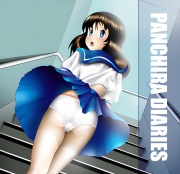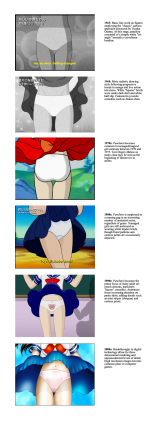Panchira
m (typo) |
Midnight68 (Talk | contribs) m (expanding article) |
||
| Line 5: | Line 5: | ||
In [[anime]] and [[manga]], ''panchira'' refers to a [[panty shot]] or [[voyeurism]] (upskirt) take. It has been used extensively by Japanese artists and animators since the early sixties. | In [[anime]] and [[manga]], ''panchira'' refers to a [[panty shot]] or [[voyeurism]] (upskirt) take. It has been used extensively by Japanese artists and animators since the early sixties. | ||
| + | |||
| + | ==Origins== | ||
| + | [[File:PanchiraTimeline.png|thumb|left|150px|<center><small>Timeline, 1963-2003.</small></center>]]The development of panchira in Japanese popular culture has been analyzed by a number of American and Japanese writers. Many observers link the phenomenon to the Westernization of Japan following [[wikipedia:World War II|World War II]]. During the occupation, fashions, ideas, and media previously unavailable were accessed by the local population, leading to a slight relaxing of earlier taboos. Western-style clothing (including [[Panties|women's underwear]]) gained popularity in the post-war period, reinforced through numerous media outlets—magazines, newspapers, films, journals, and comics. | ||
| + | |||
| + | In 1969, the Japanese oil company Maruzen Sekiyū released a television commercial featuring Rosa Ogawa in a mini-skirt that gets blown up by the wind and her lips forming an 'O' in surprise. This led to children imitating her line "Oh! Mōretsu" (Oh!モーレツ, too much, radical), and a fad for sukāto-mekuri (スカート捲り skirt-flipping). Ogawa subsequently appeared in a TV show ''Oh Sore Miyo'' (Oh! それ見よ, literally "look at that," but actually a pun on 'O Sole Mio,' a neapolitan song 'my sunshine') that again featured scenes of her mini-skirt blowing up. | ||
| + | |||
| + | By the late 1960s, panchira had spread to the mainstream comic industry, as fledgling manga artists such as [[wikipedia:Go Nagai|Go Nagai]] began exploring sexual imagery in boys' comics ([[wikipedia:Shōnen manga|shōnen manga]]). Adult manga magazines had existed since 1956 (e.g. [[wikipedia:Weekly Manga Times|Weekly Manga Times]]), but it is significant to note the introduction of sexual imagery into boys' manga. Millegan argues that the [[wikipedia:Ecchi|ecchi]] genre of the 1970s rose to fill a void left by the decline of [[wikipedia:Osaka|Osaka]]'s lending library network: | ||
| + | |||
| + | :<small>Japanese comics did not seriously begin exploring erotic themes until the sixties, with the collapse of the pay-library system (largely brought about by the unexpected success of cheap comic magazines such as Kodansha Publishing's Shōnen Magazine). Artists working for the pay-library system had already pioneered the depiction of graphic violence, and had proudly declared that they were drawing gekiga ("drama pictures"), not mere comics. In the search for realism (and readers), it was inevitable that sex would soon make an appearance. | ||
| + | |||
| + | :As the Japanese comics market diversified, sex spread beyond the gekiga to just about every conceivable niche in the marketplace. The gekiga continued their realistic and often violent depictions, but the other major divisions in the manga world developed their own approach. Boys' comics began to explore "cute" sex, mainly consisting of panchira ("panty shots") and girls in showers. | ||
| + | </small> | ||
| + | |||
According to anecdotal sources in Japan, the convention is believed to have started with Tezuka Osamu, whose character designs for Uran ("Astro Girl" in English, from the ''Astro Boy'' comic strip (Japanese: ''Tetsuwan Atom'')) incorporated an improbably brief hemline. The practice was transferred to animation when Astro Boy was adapted for television in 1963. Confined mainly to harmless children's series throughout the remainder of the decade, panchira took on more fetishistic elements during the early seventies, most notably in Tezuka's ''Marvelous Melmo'' (1971), Toei Doga's adaptions of Go Nagai's ''Cutey Honey'' (1973), and Inoue Tomo's ''Majokko Megu-chan'' (1974).{{Fact|date=February 2007}} | According to anecdotal sources in Japan, the convention is believed to have started with Tezuka Osamu, whose character designs for Uran ("Astro Girl" in English, from the ''Astro Boy'' comic strip (Japanese: ''Tetsuwan Atom'')) incorporated an improbably brief hemline. The practice was transferred to animation when Astro Boy was adapted for television in 1963. Confined mainly to harmless children's series throughout the remainder of the decade, panchira took on more fetishistic elements during the early seventies, most notably in Tezuka's ''Marvelous Melmo'' (1971), Toei Doga's adaptions of Go Nagai's ''Cutey Honey'' (1973), and Inoue Tomo's ''Majokko Megu-chan'' (1974).{{Fact|date=February 2007}} | ||
| Line 14: | Line 27: | ||
In what can be viewed as a form of self-referential parody, some anime and related productions feature jokes centred around someone's reaction to off-screen panchira. Examples include: | In what can be viewed as a form of self-referential parody, some anime and related productions feature jokes centred around someone's reaction to off-screen panchira. Examples include: | ||
| − | *In the panchira-heavy anime Agent Aika, a man avoids an all-female patrol by hiding under a grate in the floor. After they have walked overhead he emerges with a huge grin and steam coming out of his ears. | + | *In the panchira-heavy anime [[wikipedia:Agent Aika|Agent Aika]], a man avoids an all-female patrol by hiding under a grate in the floor. After they have walked overhead he emerges with a huge grin and steam coming out of his ears. |
*Blue Seed | *Blue Seed | ||
*Colorful | *Colorful | ||
Revision as of 02:23, 19 November 2023
Panchira (パンチラ) means upskirt in Japan. The word is a portmanteau of "panty" (パンティー, pantī) and chira, the Japanese sound symbolism representing a glance or glimpse.
Panchira is an expression used by Japanese women to warn each other that their underwear is visible; the term carries risqué connotations similar to the phrase "your slip is showing" in English usage.
In anime and manga, panchira refers to a panty shot or voyeurism (upskirt) take. It has been used extensively by Japanese artists and animators since the early sixties.
Origins
The development of panchira in Japanese popular culture has been analyzed by a number of American and Japanese writers. Many observers link the phenomenon to the Westernization of Japan following World War II. During the occupation, fashions, ideas, and media previously unavailable were accessed by the local population, leading to a slight relaxing of earlier taboos. Western-style clothing (including women's underwear) gained popularity in the post-war period, reinforced through numerous media outlets—magazines, newspapers, films, journals, and comics.In 1969, the Japanese oil company Maruzen Sekiyū released a television commercial featuring Rosa Ogawa in a mini-skirt that gets blown up by the wind and her lips forming an 'O' in surprise. This led to children imitating her line "Oh! Mōretsu" (Oh!モーレツ, too much, radical), and a fad for sukāto-mekuri (スカート捲り skirt-flipping). Ogawa subsequently appeared in a TV show Oh Sore Miyo (Oh! それ見よ, literally "look at that," but actually a pun on 'O Sole Mio,' a neapolitan song 'my sunshine') that again featured scenes of her mini-skirt blowing up.
By the late 1960s, panchira had spread to the mainstream comic industry, as fledgling manga artists such as Go Nagai began exploring sexual imagery in boys' comics (shōnen manga). Adult manga magazines had existed since 1956 (e.g. Weekly Manga Times), but it is significant to note the introduction of sexual imagery into boys' manga. Millegan argues that the ecchi genre of the 1970s rose to fill a void left by the decline of Osaka's lending library network:
- Japanese comics did not seriously begin exploring erotic themes until the sixties, with the collapse of the pay-library system (largely brought about by the unexpected success of cheap comic magazines such as Kodansha Publishing's Shōnen Magazine). Artists working for the pay-library system had already pioneered the depiction of graphic violence, and had proudly declared that they were drawing gekiga ("drama pictures"), not mere comics. In the search for realism (and readers), it was inevitable that sex would soon make an appearance.
- As the Japanese comics market diversified, sex spread beyond the gekiga to just about every conceivable niche in the marketplace. The gekiga continued their realistic and often violent depictions, but the other major divisions in the manga world developed their own approach. Boys' comics began to explore "cute" sex, mainly consisting of panchira ("panty shots") and girls in showers.
According to anecdotal sources in Japan, the convention is believed to have started with Tezuka Osamu, whose character designs for Uran ("Astro Girl" in English, from the Astro Boy comic strip (Japanese: Tetsuwan Atom)) incorporated an improbably brief hemline. The practice was transferred to animation when Astro Boy was adapted for television in 1963. Confined mainly to harmless children's series throughout the remainder of the decade, panchira took on more fetishistic elements during the early seventies, most notably in Tezuka's Marvelous Melmo (1971), Toei Doga's adaptions of Go Nagai's Cutey Honey (1973), and Inoue Tomo's Majokko Megu-chan (1974).Fact?
From that point on, panchira was inextricably linked with the lewd humor that would, in time, become a staple of Japanese animation and entertainment in general (see Ecchi). In the present day, panchira pervades almost every known anime genre, making it - arguably - one of the defining characteristics of the artform. It is particularly prevalent in so-called harem anime, adult romances and hentai.
Indirect Panchira
In what can be viewed as a form of self-referential parody, some anime and related productions feature jokes centred around someone's reaction to off-screen panchira. Examples include:
- In the panchira-heavy anime Agent Aika, a man avoids an all-female patrol by hiding under a grate in the floor. After they have walked overhead he emerges with a huge grin and steam coming out of his ears.
- Blue Seed
- Colorful
- Iketeru Futari
- Najica Blitz Tactics
- Air Master
- Ikki Tousen
- Kirameki Project
- AIKa R-16: Virgin Mission
- In an episode of the anime Trigun, a female hostage shoots her captor with a weapon held between her feet, since her hands are tied. The captor's last words are "They were white."
- In the OEL-manga (Original English-language-manga) webcomic Megatokyo, a miniskirted schoolgirl is crouching beside an injured man who complains of seeing spots. She hits him before realising he didn't mean her underwear because she's wearing stripes.
See also
| This page uses content from SM-201; the original article can be viewed here. |

